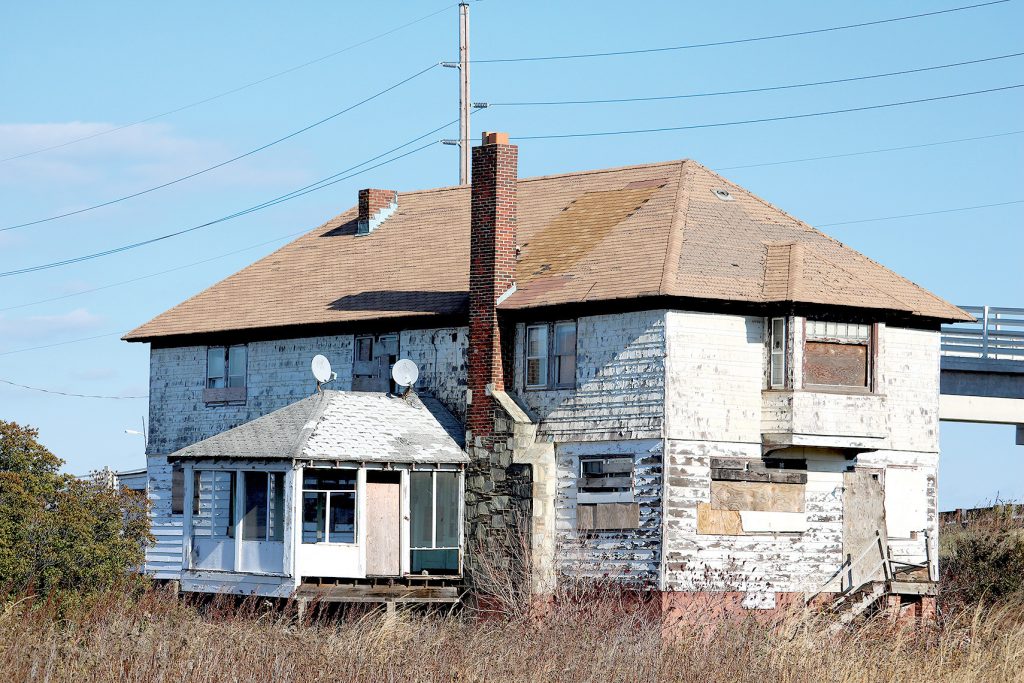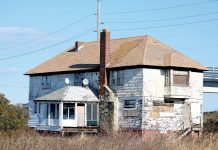
By Sunayana Prabhu
SANDY HOOK – A growing coalition of preservationists, elected officials and residents is calling on the National Park Service (NPS) to halt plans to demolish the historic William Sandlass House, a 19th-century structure located at the entrance to the Gateway National Recreation Area on Sandy Hook.
The Sandlass House, built from timbers salvaged from one of America’s earliest roller coasters, once served as the central hub of the now-lost Highland Beach Resort. The resort drew tens of thousands of vacationers for more than seven decades, transforming the Sandy Hook shoreline into a bustling center of seaside entertainment before the land was acquired by the state in 1962.
Now, the building faces an uncertain future.
Last fall, the NPS announced a significant update about plans to demolish the Sandlass House, also known as Building 600, located at 600 Hartshorne Drive. In an email response about the status of the building, Daphne Yun, public affairs officer with Gateway National Recreation Area, said the building is “unoccupied, severely deteriorated, and unsafe.”
Since Super Storm Sandy in 2012, the NPS has “consistently noted that this building is not a viable investment because the location of the building is highly vulnerable to future coastal storms,” said Yun.
Through a formal process in 2014, the park service identified the Sandlass House for demolition. In 2016, as an alternative to demolition, “the park also offered that the building could be removed and relocated outside of the park by any interested party,” said Yun. However, in 2023-2024, the NPS worked with an external contractor and found the property “ineligible per the National Register criteria,” said Yun.
The New Jersey State Historic Preservation Office concurred with this determination in February 2024. Yun noted that all materials associated with the property “were reviewed” and, in May 2024, the Keeper of the National Register of Historic Places determined the property ineligible.
“To ensure full compliance with recent National Historic Landmark Program guidance, the Park is requesting a review regarding the contributing status of the Sandlass House (Building 600) to the Fort Hancock and Sandy Hook Proving Ground Historic District,” Yun confirmed.
A Connection to the Past
Although empty and deteriorating for almost a decade, members of the community and area nonprofits are determined to restore the house that was once a busy summer resort on the Jersey Shore to its glory days.
“This house isn’t just a building – it’s a symbol of the Jersey Shore’s rich history and the memories of generations who cherished Highland Beach,” Dina Long, former Sea Bright mayor and spokesperson for the Jersey Coast Heritage Museum (JCHM), said in a press statement issued by JCHM. “Demolishing it would erase a tangible connection to the past.”
The Jersey Coast Heritage Museum has led a more than decade-long effort to preserve and restore the structure, submitting multiple restoration proposals and gathering over 3,000 petition signatures. The campaign has gained momentum again due to a letter sent May 9 by Gov. Phil Murphy in support of the Sandlass House preservation. In the letter addressed to Minka Sendich, acting superintendent, NPS, Gateway National Recreation Area, Murphy acknowledged the efforts of the NPS and the 21st Century Fort Hancock Advisory Committee – which was disbanded earlier this year by the Trump administration – in restoring and repurposing several military structures at Sandy Hook.
“It is equally important to the local community that NPS makes every effort to do the same for civilian structures that played a major part on making the Jersey Shore the tourist attraction it is today,” Murphy said in the letter. As a resident of Middletown Township, near Sandy Hook, Murphy requested the NPS “revisit the demolition order and reconsider the house for adaptive reuse through the Fort Hancock Leasing Program, which would give visitors and residents a glimpse into Monmouth County’s rich history while also contribut- ing to Monmouth County’s vibrant tourism industry.
The movement to save the Sandlass House has now garnered support from several officials and nonprofits. U.S. Rep. Frank Pallone Jr. (D-6), Sen. Andy Kim (D-3), Monmouth County commissioners, the nonprofit Sandy Hook Foundation, and the mayors of Sea Bright and Highlands, among many others, have urged the NPS to reconsider its decision.
“The reason that we’ve taken it to this level is that late last fall, the Park Service announced that they were going to proceed with demolition on the house, so that’s really been the catalyst for us recently to communicate with the Park Service,” Frank Smith, vice president, JCHM explained on a phone call.
Yet the Park Service has so far stood firm, citing safety concerns and declaring the house ineligible for the National Register of Historic Places – a conclusion preservationists strongly dispute. “The amount of spending that the Park Service would have to do to demolish the house has been estimated at in excess of a million dollars. And you know, given the current climate, that kind of spending seems cer tainly out of place, especially considering that there’s private funding available to rehabilitate the house,” Smith argued.
“We’re really in kind of a waiting game to understand what the next steps are,” he said.
In response to questions about the demolition dates, Yun said, “Sandy Hook Building 600 has been included in a package of demolitions for which planning is underway but has not been completed.”
The Sandlass House has stood largely untouched since the NPS acquired the property in 1972. Over the years, community members, preservationists, and even current lessees of nearby historic structures at Sandy Hook have expressed interest in renovating the house, which is situated near the Twin Lights and along a narrow stretch between the Shrewsbury River and the Atlantic Ocean.
“We’re not asking for a miracle,” Susan Sandlass Gardiner, author of “Sandy Hook’s Lost Highland Beach Resort” and a descendant of the original resort founder, said in JCHM’s press release. “We’re asking for the National Park Service to fulfill its mission of preserving the past for future generations. They can readily accomplish this by allowing the property to be made available through the leasing program.”
Supporters see the house as a historic landmark and a potential asset for heritage tourism and local economic development. Advocates have pointed to other successful preservation efforts in the region, such as the transformation of the T. Thomas Fortune House in Red Bank into a cultural center.
“The expense of preserving a cultural touchstone such as the Sandlass House should not be calculated purely in dollars and cents,” Mark Stewart of the Twin Lights Historical Society said in the release. “The permanent loss of a piece of history comes at a much higher cost.”
Although no definitive demolition date has been announced, the NPS has signaled its intent to proceed. Meanwhile, the Jersey Coast Heritage Museum and its supporters continue to press their case, urging the public to contact officials and share their support on social media using the #SaveSandlassHouse hashtag.
“This building stands like a lonely sentinel to the past,” said Smith. “If it’s destroyed, that loss will be felt – and questioned – for generations to come.”
The article originally appeared in the May 22 – 28, 2025 print edition of The Two River Times.














